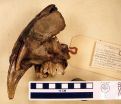(Press-News.org) As we walk along a forest path, the soil beneath our feet seems like a uniform substance. However, it is an intricate network of soil particles, pores, minerals, soil microbes, and more. It is awash in variety.
Soil is a living, dynamic substance, and the microbial life within it is crucial to providing plant life with the food they need to grow. The microbes can be bacteria or fungi, but both need space--the pores--for a good living environment.
Soil particles that clump together are aggregates. These are the architectural building blocks of soil. Their presence has a major effect on the behavior of the soil as a community. Multiple processes form the aggregates: cycles of wetting-drying, thawing-freezing, earthworm activity, actions by fungi, and interaction with plant roots.
No matter what formed the aggregates, the pores are affected. So are the microbes living in them.
Sasha Kravchenko, a soil scientist and professor at Michigan State University, studies soils and their pores in different agricultural systems. Her recent work showed that long-term differences in soil use and management influence not only the sizes and numbers of soil aggregates, but also what the pores inside them will look like.
"Pores influence the ability of bacteria to travel and access soil resources," Kravchenko says. In return for this good home, the microbes help plants access essential nutrients.
"The numbers of bacteria that live in the soil are enormous," says Kravchenko. "However, if we think about the actual sizes of the individual bacteria and the distances in a gram of soil - that soil is actually very scarcely populated."
To give an idea of what bacterial communities might look like, Kravchenko gives this image: Imagine looking out an airplane window at night over the Midwest. "It's mostly darkness with occasional bright specks of lone farms - those represent individual bacteria.
Occasionally, you'll see bright spots of small towns - those would be bacterial colonies. Rarely, you'll see a larger town or city."
Kravchenko's work compared two contrasting agricultural systems. The soil in one system, referred to as conventional in the study, grew crops such as corn in summers. Then the soil was barren from the time of main crop harvest through planting the following spring. The soil in the other system, the cover crop system, had live vegetation year-round.
"These systems have been in place since 1989, so there was plenty of time for the differences between the two systems...to develop," Kravchenko says. "Most of the changes in soil characteristics do not happen overnight. They need time to develop to such an extent that will be sufficient for researchers to detect those changes using currently available measurement tools."
Several surprising observations sprang from the study. First, the aggregates of the two agricultural systems developed different pore characteristics. The aggregates from soil in the cover crop system were more complex and varied in their interior pore structures with more large and medium-sized pores. The conventional system had more small pores spread more evenly through the entire aggregate.
Moreover, microbial communities living in individual aggregates from the same system did not look very much alike. This indicates that an individual aggregate may be a unique system of its own with its own physical build and structure. Much like neighboring cities, an aggregate's community of inhabitants might be quite different from the community next to it.
Within individual aggregates, different bacteria appeared to prefer different conditions. Many of them liked the areas that had a lot of pores with smaller (30-90 micron) diameter, while others preferred being around large (more than 150 micron) pores. "We don't know for sure why that was so, but it is likely that pores of this size provided optimal settings in terms of transport of nutrients, fluxes of air and water, and ability of bacteria to reach and decompose plant residues," Kravchenko says.
These findings highlight the complex interaction of soil particles, pores, microbes, and the plants that grow in them.
Kravchenko and her team used x-ray computed tomography (similar to a medical CT scan). Keeping the aggregates intact gave them an opportunity to view how the soil particles, pores, and particulate organic matter interact in their natural state. "There is only so much we can learn about how soil functions if we work with disturbed soil samples. To get a complete picture we need to look at soil in its intact form."
The research was published in the Soil Science Society of America Journal.
INFORMATION:
Alexandria, VA - Analyzing thousands of records, researchers have reinforced the claim that for marine life, bigger has been better for the last 542 million years. The study examined Cope's rule - the idea, named for paleontologist Edward Drinker Cope, that species evolve to larger sizes over time.
With the help of undergraduate students and high-school interns, the researchers compiled information on five major marine phyla, including arthropods, brachiopods, chordates, echinoderms and mollusks. Find out how much bigger things got in the June issue of EARTH Magazine: ...
New research shows that the fearsome teeth of the saber-toothed cat Smilodon fatalis fully emerged at a later age than those of modern big cats, but grew at a rate about double that of their living relatives. The findings, published today in the journal PLOS ONE and based on a new technique that combines isotopic analysis and x-ray imaging, for the first time provide specific ages for developmental events in Smilodon, notably in their teeth. The study estimates that the eruption rate of S. fatalis's permanent upper canines was 6 millimeters per month--double the growth ...
Statins are a hugely popular drug class used to manage blood cholesterol levels and reduce the risk of heart disease. Previous studies had raised questions about adverse behavioral changes with statins, such as irritability or violence, but findings with statins have been inconsistent. In the first randomized trial to look at statin effects on behavior, researchers at the University of California, San Diego School of Medicine report that aggressive behavior typically declined among men placed on statins (compared to placebo), but typically increased among women placed on ...
A newly-discovered, 48-million-year-old fossil, known as a "Jesus lizard" for its ability to walk on water, may provide insight into how climate change may affect tropical species, according to a study published July 1 in the open-access journal PLOS ONE by Jack Conrad from American Museum of Natural History.
Modern relatives of the Jesus lizard live in an area stretching from central Mexico to northern Colombia, flourishing in the higher temperatures found at the equator. Members of various animal, plant, fungal, and other clades currently confined to the tropics or ...
An international team of researchers has found some of the first solid evidence that narcolepsy may be a so-called "hit-and-run" autoimmune disease.
The researchers sought to determine why, of two different flu vaccines widely deployed during the 2009 swine flu pandemic, only one was associated with a spike in the incidence of narcolepsy, a rare sleep disorder.
A paper describing their findings will be published July 1 in Science Translational Medicine. Lawrence Steinman, MD, a professor of pediatrics and of neurology and neurological sciences, is the senior author. ...
While most Americans do not support policies designed to increase distribution of naloxone - a medication that reverses the effects of a drug overdose - certain types of educational messages about its lifesaving benefits may bolster support for its use, new Johns Hopkins Bloomberg School of Public Health research suggests.
In a report published July 1 in the journal PLOS ONE, the researchers say that combining educational messages about naloxone with sympathetic narratives about people who could have been saved had the drug been available could be key to increasing support ...
Widely hailed as 'green' sources of renewable energy, hydroelectric dams have been built worldwide at an unprecedented scale. But research from the University of East Anglia reveals that these major infrastructure projects are far from environmentally friendly.
A study published today in PLOS ONE reveals the drastic effects of the major Amazonian Balbina Dam on tropical rainforest biodiversity.
The research reveals a loss of mammals, birds and tortoises from the vast majority of islands formed by the creation of the vast Balbina Lake, one of the world's largest hydroelectric ...
Vitamin B12 supplements offer no benefits for neurological or cognitive function in older people with moderate vitamin B12 deficiency, according to a new study published in the American Journal of Clinical Nutrition.
Around one sixth of people in the UK aged over 75 have vitamin B12 deficiency, which when severe can lead to significant problems in the nervous system including muscle weakness, problems with walking, tiredness, and pins and needles, as well as depression and problems with memory and other important everyday cognitive functions. Vitamin B12 is found in everyday ...
New collaborative research between NOAA, University of Alaska and an Alaskan shellfish hatchery shows that ocean acidification may make it difficult for Alaskan coastal waters to support shellfish hatcheries by 2040 unless costly mitigation efforts are installed to modify seawater used in the hatcheries.
"Our research shows there could be significant effects from ocean acidification on Alaska's emerging shellfish hatchery industry in a matter of two and half decades," said Jeremy Mathis, Ph.D., an oceanographer at NOAA's Pacific Marine Environmental Laboratory and a ...
Mandatory targets to reduce salt in processed food would help tackle inequalities in coronary heart disease that lead to excess deaths in deprived areas of England, according to research by the University of Liverpool.
Consuming high amounts of salt causes high blood pressure which increases the risk of cardiovascular disease. Current average UK salt intakes are around eight grams per adult per day, whilst the UK government recommends less than six grams per day. Individuals living in more deprived areas of England often consume larger amounts of salt, and this contributes ...




